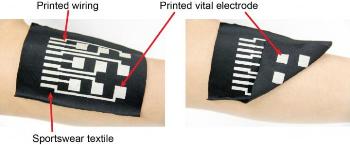Researchers at the University of Tokyo have invented a new conductive ink that can be used to print sensors onto wearable technologies.
 Electrodes, wires, and via holes can be printed by a single step printing process. The muscle activity sensor was produced by printing once on each side of the material's surface. (Credit: Someya Laboratory)
Electrodes, wires, and via holes can be printed by a single step printing process. The muscle activity sensor was produced by printing once on each side of the material's surface. (Credit: Someya Laboratory)
The ink will be used in printed electronics, which will allow sensors to be incorporated into electronic apparel for measuring biological data, including heart rate and muscle contraction.
At present, printed electronics, including LEDs, solar panels and transistors, are mainly printed on hard or rigid materials, such as paper or plastics. For wearable devices, materials would need to be soft and stretchy to be comfortable and well fitting, but it has been challenging to produce an ink that is elastic as well as conductive and can be printed in a simple, single step process.
The new work carried out by Professor Takao Someya and his team at the University of Tokyo's Graduate School of Engineering has resulted in the fabrication of an elastic and easily printable conducting ink that can be patterned on textiles with a single printing step. The ink was formulated using fluorine surfactant, fluorine rubber, organic solvent and silver flakes. It displayed high conductivity characteristics even after stretching it to thrice its original length - a record for stretchable conductors which can normallbe extended to 2.5 times their original length.
"Our team aims to develop comfortable wearable devices. This ink was developed as part of this endeavor. The biggest challenge was obtaining high conductivity and stretchability with a simple one-step printing process. We were able to achieve this by use of a surfactant that allowed the silver flakes to self-assemble at the surface of the printed pattern, ensuring high conductivity," Someya commented.
Video courtesy of Professor Takao Someya
The team used this ink to produce a wrist-band muscle activity sensor. An elastic conductor was printed onto sportswear material, and this was combined with an organic transistor amplifier circuit. The sensor features nine electrodes that are placed 2 cm apart from one another in a 3 x 3 grid, and can detect muscle electrical potentials to measure muscle activity.